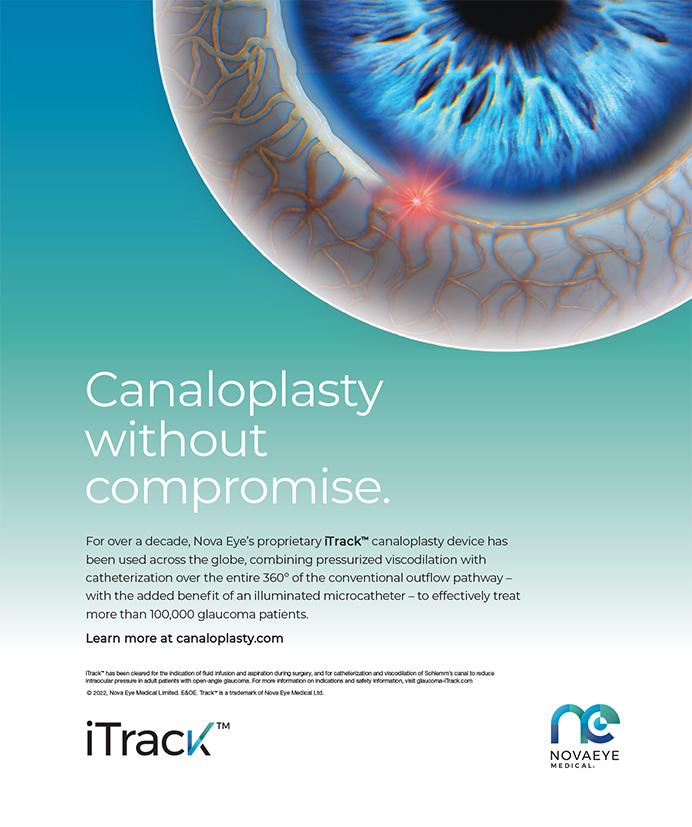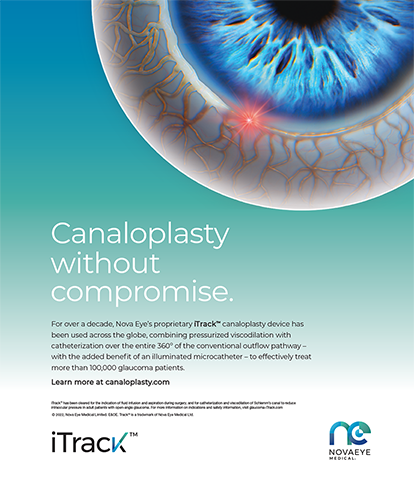Why I prefer surface ablation.
THOMAS G. ABELL, MD
As an investigator in the American LASIK Study, I had an exemption allowing me to perform LASIK when PRK was the only approved modality. Therefore, I was very comfortable with flaps, including lifting them for all enhancements. Prior to 2006, I rarely performed surface ablation. This changed in 2006 when a patient presented to me with a BCVA of 20/30 in her dominant distant eye. She had been treated for monovision with LASIK bilaterally in 2001 and had a BCVA of 20/20 preoperatively. She had a minimal refractive error, but subjectively and objectively, there was no improvement in her BCVA over her UCVA. The visual reduction appeared to be secondary to microstriae in the flap with irregular astigmatism. I felt that lifting the flap and treating the residual refraction were not an option. After discussing all of the available options with the patient and her husband, we decided on a PRK enhancement. Her resulting UCVA of 20/15 far exceeded everyone’s expectations.
SUPERIOR RESULTS
After my first PRK enhancement, I had questions. When and how should one perform PRK enhancements? I conducted an in-office study to assess the safety and effectiveness of PRK enhancements before fully committing to the technique.
The study was a 3-month comparison of 168 LASIK, 54 primary PRK, and 15 enhancement PRK treatments. The PRK treatments were performed on topographical anomalies, flap anomalies, or epithelial basement membrane dystrophies. The Orbtek Orbscan (Bausch + Lomb, Rochester, NY) anomalies included inferior displacement of the anterior or posterior float, posterior float of more than 40 µm, inferior steepening of more than 1.50 D and keratometry of more than 47.00, pachymetry of more than 500 µm, inferior pachymetry of more than 50 μm more than central pachymetry, 3-mm irregular astigmatism of more than 2.00 D, and 5-mm irregular astigmatism of more than 3.00 D. The BCVA percentage in the enhancement PRK cohort was naturally less than the primary treatments, but they were all 20/30 or better. For the study, I used the WaveLight Allegretto Wave excimer laser (Alcon Laboratories, Inc., Fort Worth, TX) and Optimized Nomograms (Refractive Surgery Consulting Group, Inc., Scottsdale, AZ) in all cohorts of PRK and LASIK. I compared the groups’ UCVA, targeted versus achieved results, and postoperative BCVA.
By 3 months postoperatively, 97.1% of patients in the LASIK group had a UCVA of 20/20 or better, 85.8% were within ±0.50 D of the targeted correction, and 98.5% had a gain or no change in BCVA. In the primary PRK group, 90.7% of patients had a UCVA of 20/20 or better, 86.0% were within ±0.50 D of the intended correction, and 86.1% gained or had no change in BCVA. In the PRK enhancement group, 60% of patients achieved a UCVA of 20/20 or better, 86.6% were within ±0.50 D of the intended correction, and 100% had a gain or no change in BCVA. There was also no haze or second enhancement needed with the PRK enhancement group compared with 1.8% of second enhancements that were needed with flap-lift enhancements. The only time I lift a flap is when I must address epithelial ingrowth. Based on the results of this study, I choose PRK for nearly all of my enhancements.
TECHNIQUE
To begin the PRK enhancement, each patient receives a tetracaine-saturated bandage contact lens. I drain the balanced salt solution from the contact receptacle and replace it with tetracaine. The tetracainesaturated bandage contact lens is placed on the eye for at least 1 hour before surgery. I remove the bandage contact lens in the OR and scrub the epithelium with an Amoils Epithelial Scrubber (Innovative Excimer Solutions Inc., Toronto, Ontario, Canada) (Figure 1). I find that this provides great anesthesia and easy epithelial removal without harming the existing LASIK flap. After the epithelium is removed, a crisp edge is obtained, which allows for quick epithelialization. Next, mitomycin C is applied to the eye for 30 seconds, and a new bandage contact lens is placed. I see the patient for follow-up on postoperative day 4, at which time reepithelialization has occurred.
It is rare that I hear any complaints of pain or discomfort after the procedure (Figure 2). The patient is treated with NSAIDs for 3 days before surgery and with 60 mg of prednisone on the day of surgery. Postoperatively, the NSAIDs are continued, along with a topical steroid and antibiotics. Ultram ER (Ortho-McNeil-Janssen Pharmaceuticals, Inc. , Titusville, NJ) is given for any breakthrough pain.
ADVANTAGES
I prefer PRK enhancements for many reasons. First, in my hands, the results are superior, and there is rarely a need for a second enhancement. Also, I view the flap as free tissue at my disposal for use. It is positioned on top of the bed and adds nothing to the structural integrity of the cornea, which virtually eliminates the danger of destabilizing the cornea or inducing ectasia, as LASIK enhancements are prone to do. PRK is also less destructive to the corneal nerves and therefore has less of an effect on the corneal tear film. PRK can remove or correct minor surface irregularities, which greatly improves patients’ quality of vision.
CONCLUSION
I have been very pleased with PRK enhancements. My results have been stellar, and I have not had any issues with haze when using mitomycin C in compliant patients. I have also been pleasantly surprised with the lack of postoperative pain, and there has been great acceptance on the part of patients. My experience with PRK enhancement has been so positive that I routinely use this modality with primary treatments for 30% of my patients.
Thomas G. Abell, MD, is the medical director and founder of Lexington Laser Eye Center, the medical director of and surgeon for AbellEyes Refractive Solutions, and the medical director of and surgeon for AbellEyes Laser Vision Correction Center in Lexington, Kentucky. He is a consultant to and on the speakers’ bureau of Alcon Laboratories, Inc. Dr. Abell may be reached at (859) 373-0300; dr.abell@abelleyes.net.
Why I prefer LASIK.
DAVID R. HARDTEN, MD
For most low and moderate myopes in younger age groups, we really have two refractive procedures to choose from— PRK and LASIK. The choice is often difficult, and we agonize over it every day in our clinical practices. We ask ourselves, is the cornea thick enough? Is the patient going to develop a complication? Which procedure is better in this specific case?
I was recently asked at the AAO Annual Meeting to argue that PRK is the better option for laser vision correction. Because I found that assignment very difficult, I thought I would attempt the other position for this article—that LASIK is better. The extensive discussion of this subject at meetings shows that there is no definitive answer.
SPEED OF RECOVERY
In the long run, the results are the same with both procedures, as reflected in most studies.1,2 Certainly, most patients want to return to work as soon as possible, experience the least amount of pain possible, and have the least hassle postoperatively. On these points, LASIK wins out over surface ablation. The epithelium is intact after LASIK, there is minimal pain, the recovery is fast, and patients need minimal medications. The “wow” factor is therefore phenomenal. New technologies, such as the femtosecond laser, allow for a smoother corneal bed, tight-fitting edges of the flap, and unsurpassed safety in LASIK compared with technologies from a few years ago. Faster femtosecond lasers have also reduced treatment times.
Because the epithelium is intact soon after LASIK, and there is no need for a bandage contact lens, most surgeons believe that the risk of infection is less after LASIK than PRK. With PRK, the long epithelial recovery time raises the chance of infectious keratitis. The time frame for stabilization of the epithelial hyperplasia in a LASIK procedure has shortened with wavefront-based treatments and better blending of the ablation zone. Although the tear film also needs to recover, the aggressive preoperative management of dry eye and blepharitis quickens recovery times and improves patients’ satisfaction with their vision. Even though a small risk of epithelial ingrowth is present with lifting the LASIK flap, I still prefer to enhance with the LASIK flap lift in the first year or 2 after LASIK. However, with late enhancements I now prefer PRK over the prior flap because of the increasing risk of epithelial ingrowth in these patients several years after LASIK. Additionally, the risk of haze with PRK over LASIK is much less now with wavefront treatments and the use of mitomycin C. Patients’ faster visual recovery after LASIK allows me to determine sooner whether the refractive result is satisfactory.
CORNEAL STABILITY
In the past, the potential for post-LASIK ectasia was a concern. Although long-term evidence is still building, the combination of tighter screening criteria and the thinner flaps of the femtosecond laser appear to have decreased the incidence of ectasia after LASIK. Because keratoconus is one of the most common forms of corneal degenerations, however, it is impossible to prevent all cases of post-LASIK ectasia. Some patients may not exhibit sufficient risk factors to warrant the decision not to offer them surgical correction. An interesting clinical finding of more aggressive screening efforts and many surgeons’ shift to PRK for laser vision correction is that some of these patients with slightly irregular topography have loose epithelium. This suggests that many may actually have anterior basement membrane dystrophy rather than keratoconus. With my ability to reduce scarring with mitomycin C, I really do not perform LASIK anymore on patients with clinical anterior basement membrane dystrophy.3
Certainly, LASIK is a poor choice in some specific cases. For example, better options include a phakic IOL in many cases of high correction, refractive lens exchange when a cataract is affecting the patient’s vision or refractive error, or PRK for eyes with loose epithelium or atypical topography.
CONCLUSION
Patients want excellent vision as quickly as possible (Figure 1). LASIK achieves that goal in most cases. Although the procedure is not appropriate for all patients, it is my choice whenever the patient meets my inclusion criteria for both LASIK and PRK.
David R. Hardten, MD, is the director of refractive surgery at Minnesota Eye Consultants in Minneapolis. Dr. Hardten may be reached at (612) 813- 3632; drhardten@mneye.com.
- Miyai T, Miyata K, Nejima R, et al.Comparison of laser in situ keratomileusis and photorefractive keratectomy results:long-term follow-up.J Cataract Refract Surg.2008;34(9):1527-1531.
- Slade SG, Durrie DS, Binder PS.A prospective, contralateral eye study comparing thin-flap LASIK (sub-Bowman keratomileusis) with photorefractive keratectomy.Ophthalmology.2009;116(6):1075-1082.
- Hardten DR, Gosavi VV.Photorefractive keratectomy in eyes with atypical topography.J Cataract Refract Surg.2009;35(8):1437-1444.


